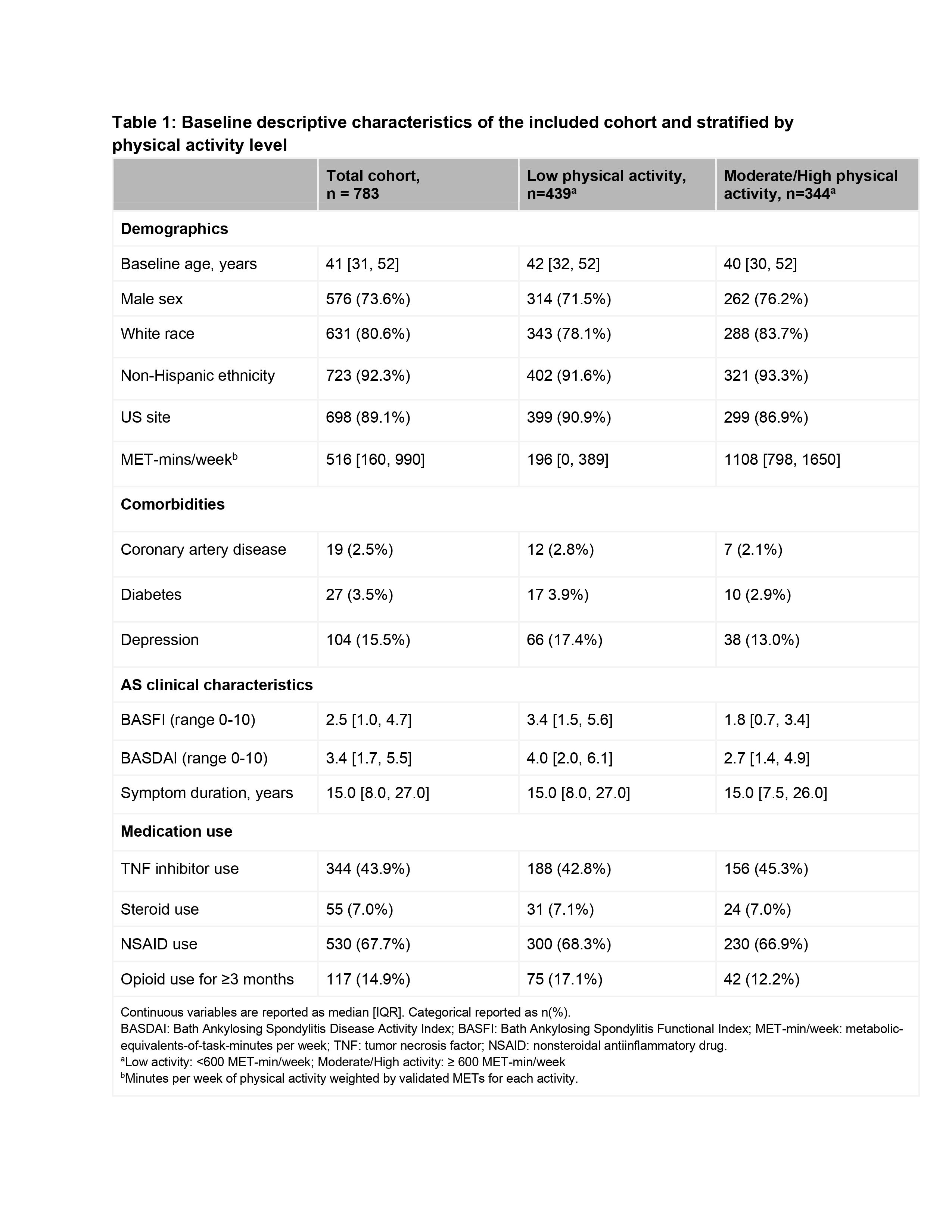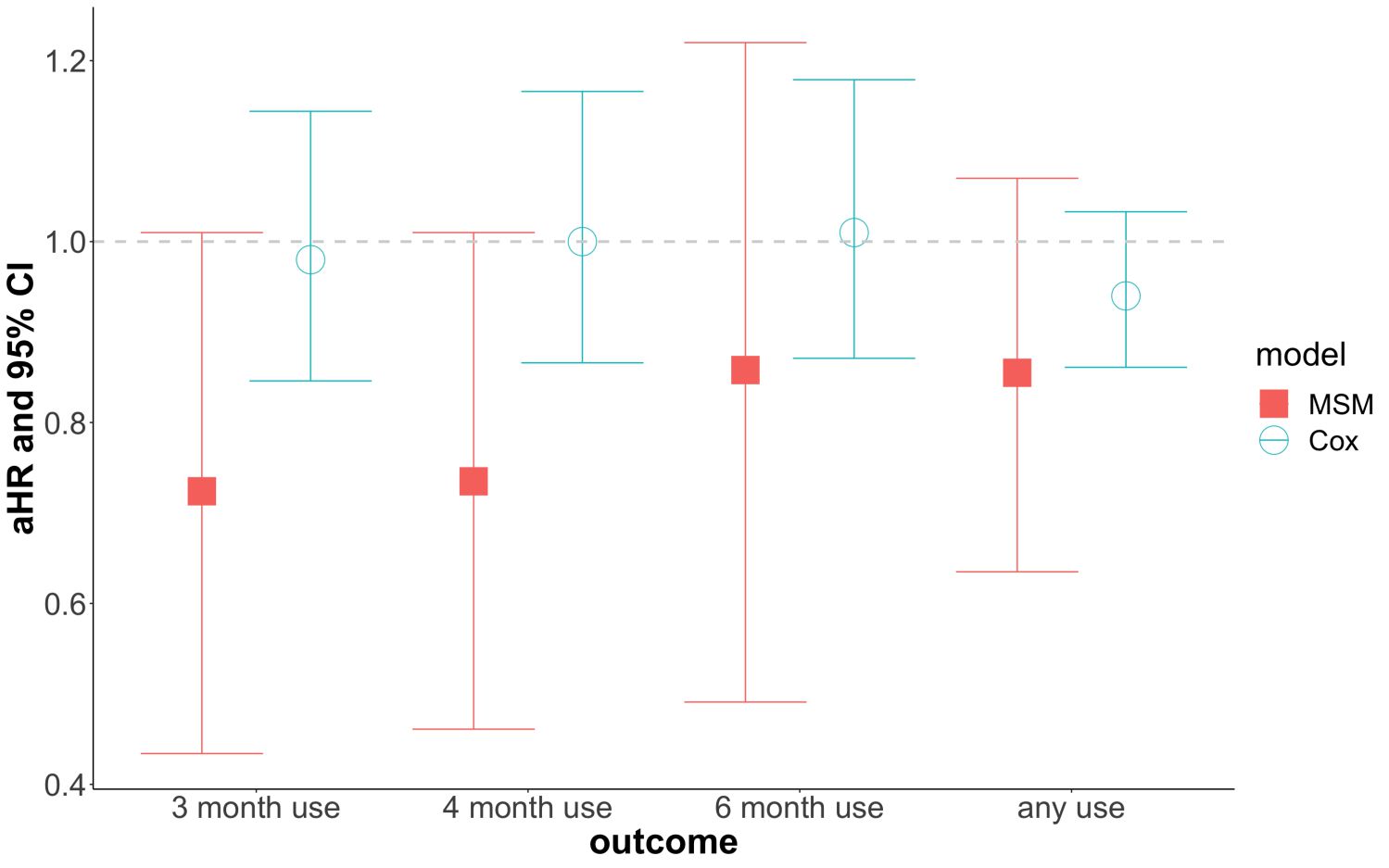Session Information
Session Type: Poster Session C
Session Time: 10:30AM-12:30PM
Background/Purpose: Pain remains a common symptom of axial spondyloarthritis (axSpA) despite availability of effective therapies. Physical activity may benefit pain and is guideline recommended but remains underutilized, while chronic opioid use remains high. Whether higher physical activity can reduce opioid use in people living with axSpA is unknown. We assessed the association of physical activity levels with chronic opioid use in a prospective radiographic axSpA (r-axSpA) cohort.
Methods: We longitudinally analyzed adults with r-axSpA in the Prospective Study of Outcomes in Ankylosing Spondylitis (PSOAS) cohort followed across 2003-2018. Clinical information, including physical activity and medication use, was collected every 6 months. The outcome, chronic opioid use, was defined as any daily opioid use for ≥3 months prior to the visit, and secondarily defined using thresholds of ≥4 months, ≥6 months, or any use. The exposure was dichotomized moderate/high versus low physical activity level, based on cumulative metabolic equivalents of task-minutes per week calculated from patient-reported physical activity based on modified International Physical Activity Questionnaire thresholds. We excluded patients with baseline chronic opioid use.
Time-varying confounders (e.g. disease activity) may be affected by the exposure of interest (treatment-confounder feedback), which is difficult to account for using standard methods. Thus, we estimated the effect of time-varying physical activity on chronic opioid use by accounting for baseline (demographics, site, symptom duration, comorbidities, study entry year) and time-dependent confounders (disease activity, physical function, medication use) using marginal structural models (MSM). We used inverse probability weighting to account for time-dependent confounders. In sensitivity analyses, we conducted time-varying Cox proportional hazards models with adjustment for the same confounders. We used multiple imputation with chained equations for missingness at the study visit level (physical activity level, comorbidities, symptom duration, disease activity, physical function, and medication use).
Results: We included 788 patients (median age 41 years, 74% male, 81% white). The low physical activity group (n=439, 56%) had higher disease activity levels and comorbidity prevalence (Table 1). In the main analysis using MSM, moderate/high physical activity had a 28% lower risk of chronic opioid use, although this was not statistically significant (HR 0.72, 95% CI 0.43-1.01) (Figure 1). For secondary outcome definitions, the magnitude of effect was attenuated in MSM models. Cox models did not demonstrate an association between physical activity levels and chronic opioid use (HR 0.98, 95% CI 0.85-1.14 for the primary outcome).
Conclusion: In this prospective r-axSpA cohort, longitudinal analyses accounting for time-varying exposures and treatment-confounder feedback suggest a possible protective effect of higher physical activity on incident chronic opioid use, although results were not statistically significant.
Abbreviations: aHR: adjusted hazard ratio; MSM: marginal structural model
Cox model adjusts for baseline age, sex, race, ethnicity, site, symptom duration, coronary artery disease, depression, diabetes, BASFI, BASDAI, and the use of TNF inhibitors, NSAIDs, and steroids
To cite this abstract in AMA style:
Kyada R, Liew J, Dubreuil M, Brown M, Ishimori M, Reveille J, Ward M, Weisman M, Gensler L. Association of Physical Activity Levels on Chronic Opioid Use in Radiographic Axial Spondylitis Patients [abstract]. Arthritis Rheumatol. 2024; 76 (suppl 9). https://acrabstracts.org/abstract/association-of-physical-activity-levels-on-chronic-opioid-use-in-radiographic-axial-spondylitis-patients/. Accessed .« Back to ACR Convergence 2024
ACR Meeting Abstracts - https://acrabstracts.org/abstract/association-of-physical-activity-levels-on-chronic-opioid-use-in-radiographic-axial-spondylitis-patients/


